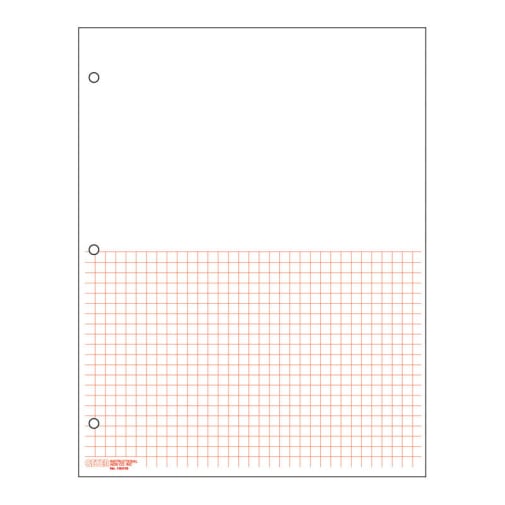This double-sided graph paper pack features a graph grid that covers the bottom half of the page, leaving the top half blank for writing or working out other math problems or subjects. The graph portion is approximately 8" x 5.25", with 19 x 32 square blocks (there are also two partial rows added on the bottom portion of the grid). The individual grid blocks are .25" each. The graph sheets are hole-punched for easy dispersing or filing of papers. Pack includes 100 sheets total of 8.5" x 11" paper.
Graph Paper, Classic Half-sheet 1/4" Squares (100 sheet pack) - Red
SKU
003937
Grade PK-AD
These icons are designed to help you quickly understand and learn important information about our products.
Teaching Method
Traditional
Teacher-centered curriculum commonly used in classrooms that may include a text, teacher manual, tests, etc.
Charlotte Mason
A methodology based on the work of a 19th century educator who maintained that children learn best from literature (Living Books), not textbooks.
Classical
A methodology based on the Latin Trivium (three stages of learning), including the grammar stage (memorization and facts), logic stage (critical thinking), and rhetoric stage (developing/defending ideas).
Unit Study
A thematic or topical approach centered around one topic that integrates multiple subject areas.
Montessori (Discovery)
A methodology based on the work of a 20th century educator that emphasizes student and sensory-driven discovery learning and real-life applications.
Other
Other methodologies
Religious Content
Secular
Contains content contrary to common Christian beliefs (i.e. evolution).
Neutral
Avoids religious or theoretical topics or presents multiple viewpoints without preference.
Christian/Religious
Faith-based or including instructional religious content.
Learning Modality
Auditory
Learns through listening, talking out loud or reading out loud.
Visual
Learns through seeing, prefers written instructions and visual materials.
Kinesthetic/Tactile (Hands-On)
Learns through moving, doing and touching.
Multi-Sensory
Curriculum that employ a variety of activities/components.
Presentation
Sequential
Curriculum progresses through well-defined learning objectives. Emphasizes mastery before moving to the next topic.
Spiral
Topics and concepts are repeated from level to level, adding more depth at each pass and connecting with review.
Conceptual/Topical
Focus is on the “why,” often with a unifying concept as well as specific skills; coverage may be broader.
Teacher Involvement
Low Teacher Involvement
Student-led materials; parent acts as a facilitator.
Medium Teacher Involvement
A mix of teacher-led time and independent student work.
High Teacher Involvement
Teacher-led lessons; may utilize discussions, hands-on activities and working together.
Additional Materials Required
No other materials needed
Everything you need is included.
Other Materials Required
There are additional required resources that are a separate purchase.
Other Materials Optional
There are additional resources mentioned or recommended but are not absolutely necessary.
Consumable
Consumable
Designed to be written in; not reusable.
Non-Consumable
Not designed to be written in; reusable.
Our Price
$6.79 $6.79 $5.85
Rainbow Savings: $0.94
Description
Publisher's Description of Graph Paper, Classic Half-sheet 1/4" Squares (100 sheet pack) - Red
Classic Half Sheet Graph Paper. Red Grid with 1/4" squares printed on the lower half of the sheet allowing room for equations and comments. 8.5" X 11" Graph paper is double sided and three hole punched making it perfect for teacher and student binders. This graph paper is great for the classroom or student homework.
Category Description for Graph Paper (100-sheet packs)
Graph paper is a must have for math class, and this 3-hole punched graph paper is a convenient, affordable option. Each package is 100 sheets (8.5" x 11") and printed on both sides on white paper in a variety of grid sizes.
Details
| Product Format: | Other |
|---|---|
| Grades: | PK-AD |
| Brand: | Geyer Instructional |
| Length in Inches: | 11 |
| Width in Inches: | 8.5 |
| Height in Inches: | 0.4375 |
| Weight in Pounds: | 0.9 |
Videos
Reviews

